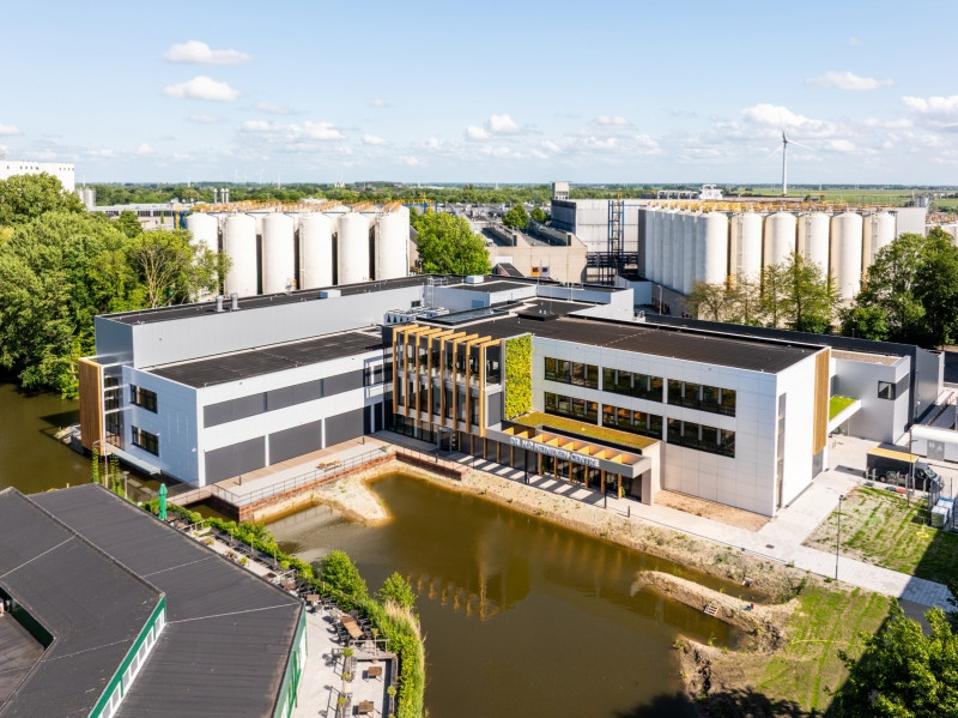When Heineken officially opened a new global research and development center in South Holland last month, the occasion was so momentous for the brewer that King Willem-Alexander of the Netherlands was in attendance.
The Dutch brewer spent $45 million euro ($52.3 million USD) on the R&D center located in the town of Zoeterwoude, roughly a 40 minute drive from the nation’s capital of Amsterdam. It has a staff of close to 100 employees that are dedicated to brewing innovation, sensory research, packaging development and supporting the development of global brands including Heineken, Amstel and Desperados. The R&D center also sits adjacent to a Heineken brewery that the company says is the largest in Europe.
“This Center enables us to innovate faster and smarter, help us to create distinctive beers and drinks, improve our brewing processes and reduce our impact on the planet,” said Dolf van den Brink, Heineken CEO and chairman, in a statement at the time of the unveiling ceremony.
Why Brewers Need To Innovate In A Complex Market
Hubert Ter Braake, director of research and development at Heineken, tells me during a recent interview that the opening of the new R&D center will propel future beverage experimentation, while also sending a message to both internal and external stakeholders that the company is very seriously committed to innovation.
“It is important that people see that you put your money where your mouth is,” says Ter Braake.
Placing a bigger bet on innovation comes at a challenging time for the broader alcoholic beverage industry. Adults are drinking less booze and instead favoring healthier products, a trend that’s proliferated in the U.S. and other international markets including across Europe. That’s led to uncertainty for the industry’s largest players, as seen most recently by the abrupt departure of Diageo CEO Debra Crew, who is stepping down after two years in that role, as the world’s largest spirits company can’t quite get a handle on where consumers are evolving.
The non-alcohol market has been particularly alluring, a portion of the business that’s expected to be worth $5 billion in the U.S. by 2028, according to industry researcher IWSR. Non-alcoholic beer is forecasted to be the primary driver of that growth, due to that market being more mature than non-alcoholic spirits or wine and greater investments in new beer brands in that space.
Brewer Already Scored A Hit With Non-Alcoholic Heineken 0.0
Non-alcoholic beer is a space where Heineken has already scored a big hit that predates the R&D center opening. The company’s Heineken 0.0 launched in 2017 and is now the highest-selling non-alcoholic beer in the world. The brewer says it has been able to achieve a commanding lead in the market by committing 10% of all media spending on responsible consumption campaigns, which included a recent advertising spot and feature tied to the F1 film starring Brad Pitt and Damson Idris.
Ter Braake says that before Heineken 0.0, the non-alcoholic beers on shelves weren’t of high quality and didn’t taste that great. And because of those reasons, buying non-alcoholic beers wasn’t considered socially acceptable. After R&D is able to craft a better tasting product, the marketers can do their job selling the brand.
“Our job is to really go one level deeper and see what are those little bit hidden needs consumers have,” says Ter Braake.
From AI To Ultimate: Heineken Charts A New Course
Newer innovations from Ter Braake’s team includes Heineken 0.0 Ultimate, a non-alcoholic brew that also has zero calories or sugar and is currently sold in Massachusetts and New Jersey. In yet another limited pilot program in Italy, the brewer is testing out Heineken Fusion, a variation of a beer that’s meant to be served as an aperitivo before starting a meal.
“We have a whole pipeline and the markets must work together to see what part of the pipeline may be more focused on that particular market,” says Ter Braake. “It’s not for nothing that we piloted Fusion in Italy or Ultimate in the U.S.; because it fits the consumers there.”
Heineken has also invested in artificial intelligence for brewing, with a focus on two key applications of that technology in use today. The first is social listening, which involves the use of AI algorithms to track and crunch data on which flavors are becoming more popular among consumers. Another AI tool at use at Heineken helps shorten new product development.
Ter Braake adds that Heineken’s innovation efforts tend to go in two distinct directions. The first is more about technology, including rethinking the use of raw materials or other methods taken during the production process which can be done more efficiently. But the second consideration set is more expansive and involves brand innovations—local projects like Fusion or Ultimate or global efforts like Heineken 0.0. In the latter case, leadership must sign on before R&D moves forward.
“We always discuss and get approval by our board, so they agree with the longer-term vision we have on what directionally the future should be for beer or for other products,” says Ter Braake.

